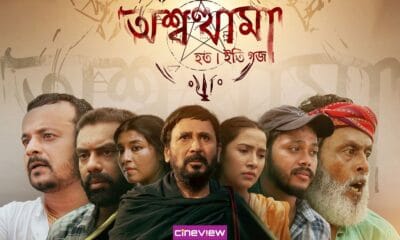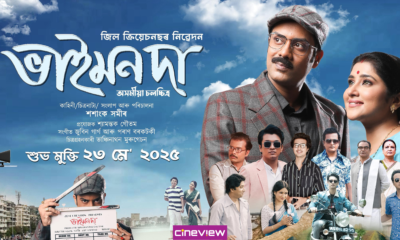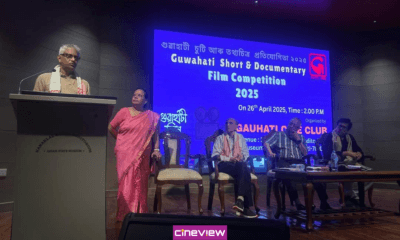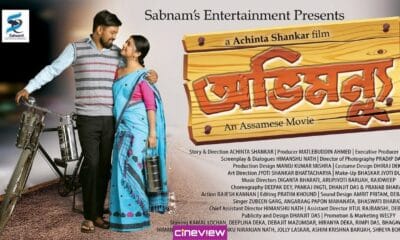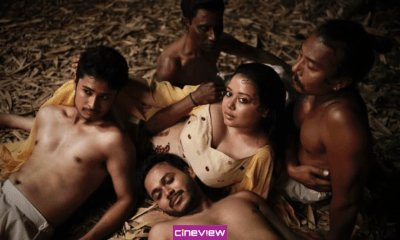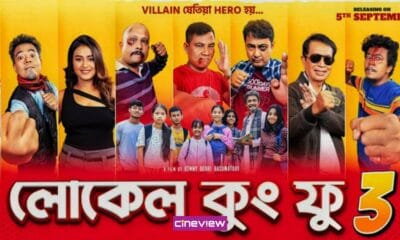Film Reviews
Bhoot Jolokiya: Just like the chili, the movie too lingers long after it’s over
From the very beginning, the film Bhoot Jolokiya creates a sense of mystery that unfolds and holds the audience’s attention.
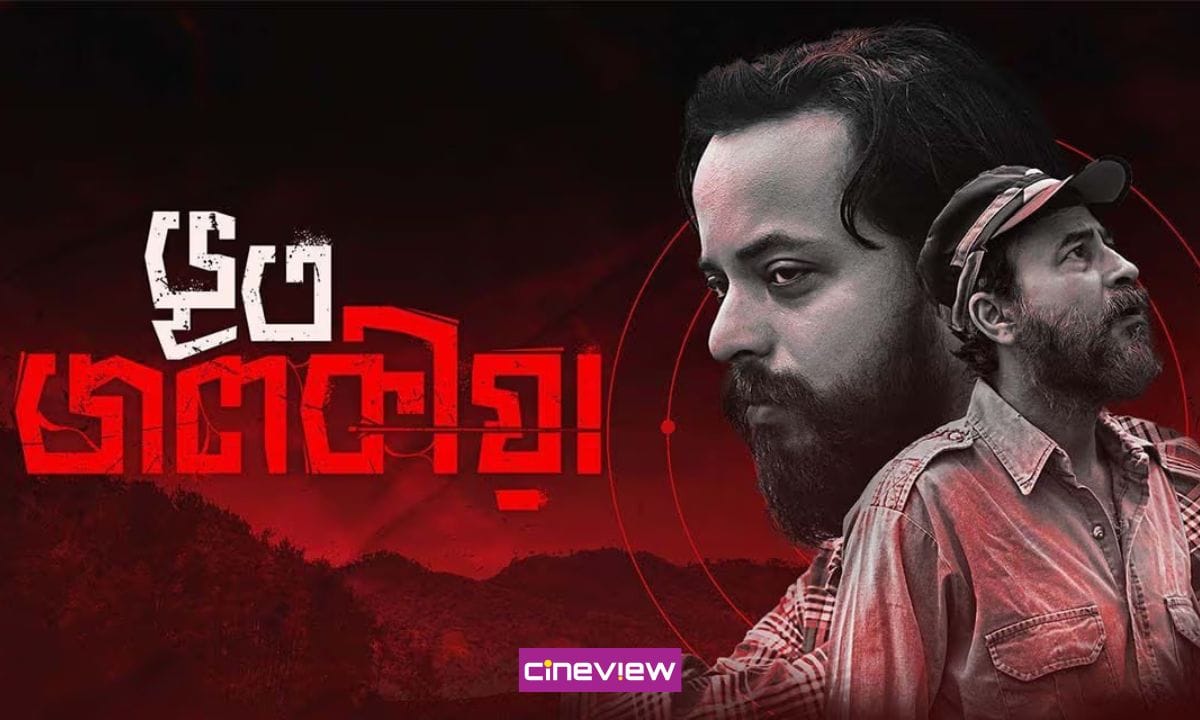
Bhoot Jolokiya – a film directed by Chinmoy Sarmah, starring Mintu Baruah and Atanu Mahanta in the lead – offers a fresh narrative experience that might make you think it’s a thriller with a touch of horror, or perhaps a horror film with guns and grit. Whatever the case, the narrative is crafted in a way that keeps you intrigued about what will come next and keeps you glued to the screen.
Jibon (played by Mintu Baruah) and Mainu (played by Atanu Mahanta) embark on a search that leads them to unearth a shocking past, keeping both them and the audience captivated with unexpected twists. This mystery intertwines elements of horror, shared trauma, and subtly addresses Assam’s socio-political past.
The wide shots, which are prevalent throughout the film, played a crucial role in helping the audience understand and reflect on the story. These shots set the stage and provided a sense of place and scale, which allowed the audience to immerse themselves in the environment and grasp the enormity of the characters’ challenges.
Whether at the beginning of the film or during the scene where Jeebon and Mainu take on a search to fulfill Mainu’s father’s last wish, the wide shots not only make the environment feel like a character in itself but also leave the audience with a sense of ambiguity, keeping them guessing and heightening the mysterious tone. For me, as a viewer, this technique worked effectively, as it left me scanning the shots for clues, which created a heightened sense of engagement and unease.
From the very beginning, the film creates a sense of mystery that unfolds and holds the audience’s attention, whether it’s the disappearance of the fish, the appearance of a girl in the middle of the forest, or the arrival of Mainu at night. Though the mystery continues, the film’s visuals leave viewers in awe, allowing them to appreciate the art Sarmah has crafted. Some visuals, particularly when Jeebon and Mainu travel by bike, reminded me of a similar sequence from Achal Mishra’s Dhuin (2022). The characters’ journey through Assam is so beautifully showcased that Papu Deka certainly deserves recognition for that sequence.
The visuals are further enhanced by the choice of locations for the shoot. Jeebon’s house, situated in the middle of nowhere, establishes a sense of mystery for the viewers. Meanwhile, Ujjal’s house, a very conventional old Assam-type home, evokes the time to which the narrative refers. In both locations, the narrative is constructed in a way that keeps the mystery intact for the audience.
While discussing the mystery, we can’t overlook the performances of the actors that made the entire narrative believable. Mintu Baruah, in the role of Jeebon, brings a sense of intensity to the story, making the character both layered and intriguing. His performance stands out for its subtlety; Baruah knows exactly when to hold back and when to let emotions surface, which keeps the character grounded while allowing the audience to feel his inner conflict. This makes it feel like watching someone from real life while the character is also part of something unusual.
Jeebon’s character is well complemented by Mainu, played by Atanu Mahanta. Mahanta not only delivers a commendable performance but also enhances the layered mystery of the narrative, for which both the writer who created the character and Mahanta, who presents it on screen, deserve credit. While Mahanta’s entire appearance contributes significantly to the narrative, his body language and expressive eyes add an interesting nuance to the character.
Apart from the solid performances of Mintu Baruah and Atanu Mahanta, who have the most screen presence in the film, the character of Pokhila, played by Violeena Bordoloi, comes across as quite promising and captivating. She manages to draw the audience’s attention with a quiet yet undeniable presence. Her character carries the responsibility of bringing the mystery to life, which she accomplishes commendably. What stands out is her ability to convey emotions through subtle expressions, making the supernatural elements of the story feel both grounded and believable. Violeena brings a unique energy to her role, proving that she’s much more than just a supporting character.
However, the storyline could have been more accommodating regarding certain plot points. In the first half, before the interval, the writing felt less impactful, with some scenes appearing rushed or underdeveloped. Key moments that could have added emotional depth or narrative complexity were skimmed over, leaving certain parts of the story feeling incomplete or disjointed. While the second half picked up in terms of pacing and tension, the initial setup lacked the same level of engagement, slightly reducing the overall impact of the film. Kishalay M.B. Baruah and Chinmoy Sarmah could have taken a more nuanced approach in their writing, which would have allowed the story to breathe and build momentum more organically.
At the same time, the film presents certain technical concerns that interrupted my engagement with the story. While the wide shots are beautifully crafted, the mid and close shots suffer from continuity issues that caused the film to lose momentum. In several scenes, particularly when a villager tells young Ujjal to flee from the village as the news has spread, I noticed a continuity issue related to the timing of the shots: the master shot was filmed in the late afternoon before sunset, while the three-shot had a darker background, indicating it was filmed in the evening.
A similar issue arises when Antara (played by Adrita Parasar) and her mother visit Jeebon’s house, where there are noticeable action continuity flaws that could have been addressed more carefully. Additionally, when Mainu meets Jeebon at his house, there are jump cuts that felt quite abrupt to me. I believe these issues could have been handled more consciously by director Chinmoy Sarmah and editor Hirak Jyoti Pathak.
While people all over social media are appreciating the background music (composed by Aparajith Sris) of the film, which certainly contributes significantly to the narrative, there are instances where it feels forced, particularly in the first half. The suspense created by the music in certain scenes seems disconnected from the visuals, which do not evoke the same tension.
Additionally, when the romantic song concludes and the narrative resumes, there’s an awkward silence for a few seconds, followed abruptly by a loud suspenseful score, which feels jarring and indicates a lack of proper transition work. This issue of transition can also be seen in the editing; for instance, when Mainu spots Pokhila’s father at the hotel, it cuts directly to the song “Pakhi Loga,” which feels abrupt and could have been executed more thoughtfully.
Still, Sarmah’s film Bhoot Jolokiya deals with a very evocative, intriguing, and unconventional narrative that will certainly provide the audience with a new taste of storytelling. Near the end of the film, the story compels you to pause and reflect on your experience watching the movie in the cinema hall. It leaves you with amazement and curiosity, ensuring that the film lingers in your mind long after the credits roll.

 Opinion5 months ago
Opinion5 months agoMorality, Obscenity and “Mou Bihu”

 Film Reviews11 months ago
Film Reviews11 months agoSundarpur Chaos or Chaos in Director’s Vision

 Film Reviews11 months ago
Film Reviews11 months agoJoy Hanu Man: The Hero Amongst Us

 Film Reviews1 year ago
Film Reviews1 year agoLocal Kung Fu 3: Is Assamese Comedy Evolving?

 Film Reviews1 year ago
Film Reviews1 year agoBidurbhai’s Shocking Caricature of Queers: Painful but Not Surprising

 Film Reviews1 year ago
Film Reviews1 year agoFor Assamese cinema to flourish, movies like Sikaar are necessary

 Film Reviews1 year ago
Film Reviews1 year agoBasumatary’s Jiya is a Beacon of Hope for Assamese Cinema

 Film Reviews11 months ago
Film Reviews11 months agoAbhimanyu: Questioning the system, one frame at a time


